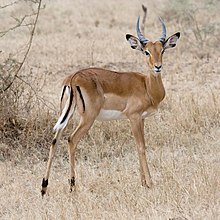Impalas
| Impala | |
|---|---|
 |
|
| Male in the Serengeti | |
| Scientific classification | |
| Kingdom: | Animalia |
| Phylum: | Chordata |
| Clade: | Synapsida |
| Class: | Mammalia |
| Order: | Artiodactyla |
| Family: | Bovidae |
| Subfamily: |
Aepycerotinae Gray, 1872 |
| Genus: |
Aepyceros Sundevall, 1847 |
| Species: | A. melampus |
| Binomial name | |
|
Aepyceros melampus (Lichtenstein, 1812) |
|
| Subspecies | |
|
|
 |
|
| Distribution:
Black-faced impala
Common impala |
|
| Synonyms | |
The impala (pronounced /ɪmˈpɑːlə,-ˈpalə/) (Aepyceros melampus) is a medium-sized antelope found in eastern and southern Africa. The sole member of the genus Aepyceros, it was first described by German zoologist Martin Hinrich Carl Lichtenstein in 1812. Two subspecies are recognised—the common impala, and the larger and darker black-faced impala. The impala reaches 70–92 centimetres (28–36 inches) at the shoulder and weighs 40–76 kilograms (88–168 pounds). It features a glossy, reddish brown coat. The male's slender, lyre-shaped horns are 45–92 centimetres (18–36 in) long.
Active mainly during the day, the impala may be gregarious or territorial depending upon the climate and geography. Three distinct social groups can be observed: the territorial males, bachelor herds and female herds. The impala is known for two characteristic leaps that constitute an anti-predator strategy. Browsers as well as grazers, impala feed on monocots, dicots, forbs, fruits and acacia pods (whenever available). An annual, three-week-long rut takes place toward the end of the wet season, typically in May. Rutting males fight over dominance, and the victorious male courts female in oestrus. Gestation lasts six to seven months, following which a single calf is born and immediately concealed in cover. Calves are suckled for four to six months; young males—forced out of the all-female groups—join bachelor herds, while females may stay back.
...
Wikipedia

